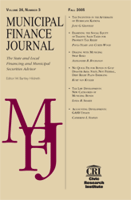Toward a Model for Assessing the Effectiveness of Tax Increment Financing—The Ohio Experience
Author: Jane Beckett-Camarata.
Source: Volume 22, Number 01, Spring 2001 , pp.1-10(10)

next article > |return to table of contents
Abstract:
Tax increment financing (TIF) is a popular economic development tool of Ohio local governments. Ohio local governments, like other local governments in the United States, are facing the need to adapt to rapidly increasing, dynamic environmental influences. As a result, financing techniques used by local governments are becoming more market-driven. Some local governments have been successful in using market-based financing techniques for economic development as a way of adapting to dynamic change and fiscal pressures. Two of the main goals of local government economic development policy in the United States are to increase the number of local jobs and to increase the tax base. Funding for local government economic development comes from many and varied sources. TIF is one way to finance economic development. TIFs allow local governments to redevelop parts of the city or county without raising taxes or spending money that should go for other services (Lehrer, 1999). One national study conducted in 1993 found that on average, about one-half of public sector economic development funds came from the local government’s general fund, about one-fifth from dedicated public sector revenue sources such as TIF, and about one-quarter from the federal government. This article examines the use of TIFs in Ohio, arguing that given their advantages, they may be underutilized, and provides a comprehensive case study from Barberton.Keywords:
Affiliations:
1: Kent State University.